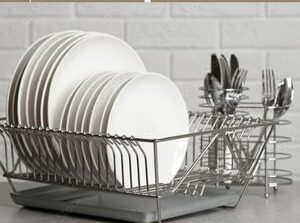The best dishrack is essential to having a well-organized kitchen because it makes dishwashing easier. The simple dish rack comes into play here, helping with the kitchen’s cleanliness and the kitchen staff’s efficiency. However, finding your way around the world of drainers can be challenging due to the abundance of available options. Do not be afraid, foodies! This all-inclusive guide will teach you all you need to know to choose the best drainer for your kitchen by diving into the essential factors and concerns.
How Dish Rack Work and What They Do
Dish racks have several practical uses beyond their seemingly primary function. The result is better air circulation, which promotes sanitary drying and inhibits bacterial growth, and no puddles to collect on your tabletop. Selecting the Appropriate Base for Your Dish Rack. Here are a few well-liked alternatives: Stainless steel is a undying and low-preservation preference because of its renown for resilience and rust resistance. On the other hand, it may show signs of damage and tear, like scratches and watermarks.
Material: plastic. You can find plastic drainers in numerous hues to complement any kitchen decor. They are lightweight, inexpensive, and clean-to-the touch. Their low sturdiness and capacity for warping or cracking through the years are drawbacks, though. Aesthetically beautiful and naturally antibacterial, bamboo drainers are an eco-friendly choice. But to keep them from bending, you must be careful. Silicone: Silicone drainers are multipurpose and practical due to their heat resistance, flexibility, and non-slip characteristics. But they might not have enough room to dry and aren’t as durable as the alternatives.
Taking Stock: How to Choose an Ideal Dish Rack for Your Home
The space on your kitchen counter and the number of dishes you usually wash are the two most important considerations when choosing the right-size dish rack. Kitchens on the Small Side: If your kitchen is short on counter space, look into wall-mounted models that make the most of vertical storage or single-tier drainers. If your kitchen has plenty of counter space, a two-tier drainer or a more significant, multi-compartment model will be more than enough to hold all your dishes and utensils.
Improving the Performance of Dish Racks:
Enhanced Functionality for Your Convenience. Beyond material and size, many factors can significantly improve your dish rack experience: A drip tray catches extra water and prevents puddles; it is detachable from the drainboard. Choose a model with a removable spout to pour away any excess water quickly. A utensil holder is a great way to protect your kitchen utensils from taking over your counter space.
Mug & Cup Holder:
They have unique slots to prevent cups and mugs from spilling everywhere. A foldable drainer is perfect for apartments or other small spaces because it takes up very little room when not in use. Dish racks with detachable components make cleanup and repair a breeze.
Dish Racks Tailored to Meet Your Every Need
Special drainer alternatives are available for individuals with unique culinary needs: Dish racks for use over the sink: Make the most of the space above your sink by installing a drainer that extends over the basin’s edge. Mats for drying: A silicone drying mat offers a surface where fragile objects or dishes washed by hand can air dry.
Keeping Things Clean: The Must-Have Procedures for Cleaning Dish Racks
Regular cleaning and disinfection are vital to keeping your dish rack germ-free. Here are a few crucial policies: Never allow water to build up in the drainboard; empty it regularly. Mould and mildew can’t grow there, so empty it often. Frequent Dish Rack Cleaning: Depending on their material, drainers should be washed with warm, soapy water and disinfected frequently. Please make sure the dish rack is ultimately air-dried before putting dishes on it after washing.
How to Get the Most Out of Your Dish Drying Machine
For the best drying results, keep these pointers in mind. Set your dishes at an angle to prevent water from collecting in one spot. Keep bowls and plates separate from one another; don’t stack them. Allow adequate air circulation by leaving space between objects. Put the handles of your utensils up so water can drain higher. A dish rack is an essential component of any kitchen.
Cleaning up after oneself inside the kitchen is straightforward enough to allow slips amid life’s other demands. On the other hand, a well-prepared and green kitchen may significantly improve our regular lives. The preferred dish rack is one of the unsung kitchen heroes that maintains matters neat without drawing much attention to itself.
Various Dish Rack Options
Dish racks are available in a wide range of sizes and styles to accommodate a variety of kitchen designs and personal tastes. Most trainers are of the traditional style, which is simple and plain with holes cut out for plates and places to put glasses and cutlery. An over-the-sink drainer is a great way to dry your dishes without taking up valuable counter space, especially if your kitchen is more minor.
A Dish Rack and Its Advantages
A dish rack may be used for more than just cleaning dishes. First, washing dishes in the machine is a great way to clear your counter. Also, drainers maximize vertical storage space, making them great for kitchens because they keep surfaces clean and prevent water from building up, improving health. Picking out a dish rack requires thinking about several things.
Ensuring that the sink can handle your daily cleaning needs in terms of size and capacity is essential. A crucial factor in the drainer’s sturdiness is its material, which might also range from bamboo to stainless steel, and its hardness level. Even though items like drip trays and tool cases make things easier to work with, they reflect the rest of your kitchen.
Principles for Proper Utilisation of a Dish Rack
To get the most out of a drainer, it would be best to recognise how to use it effectively. Put the dishes in a way that makes sense. Put the more significant items, like reducing forums and plates, on the lower shelf and the smaller ones, like cups and equipment, on the upper shelf. The dishes must be installed at an angle for the water to drain correctly. To avoid mold, empty the drip tray and smooth the sink frequently.
Dish Rack Substitutes
There are other ways to dry dishes than a drainer, but they are more handy. Towel drying is a more hands-on method, but dishwashers also include a drying cycle that people can use. An additional option is to let the dishes air dry on the countertop, though this can cause them to dry more slowly.
New Developments in Dish Racks
Dish rack technology has progressed to the point where new features have been developed to improve the user experience. Self-draining drainers send any overflow water straight into the washbasin, lessening the need to clean up afterward. Adjustable configurations can be used to create various storage solutions to suit multiple dish sizes and shapes.Alternatives to plastic drain covers encompass rubber and bamboo, which might be eco-friendly.
Renowned Brands of Dish Racks
Many manufacturers create high-quality drainers to cater to different tastes and requirements. Stylish and functional, the Umbra and Joseph drainers are also popular options.
Making Your Dish Rack: 20 Creative Ideas
There is no shortage of do-it-yourself dish rack inspiration for individuals who prefer to work with their hands. Make dish-drying racks from repurposed items like wire baskets or wooden crates. Design your DIY drainer according to your kitchen’s dimensions and add features like hooks or partitions.
In summary
Lastly, a drainer is an essential appliance for any kitchen due to its ability to provide space and organisation. Whether you choose a conventional drainer or explore other drying methods, investing in a high-quality drainer will help you simplify your kitchen tasks and keep everything neat.
FAQs
Are dish racks capable of supporting heavy cookware?
Though most dish racks are made to carry flatware and silverware, others may be able to support heavier objects like saucepans and stovetops. Before putting heavy things on the drainer, ensure it can handle the weight.
How can I prevent my dish rack from getting moldy?
Say you want to keep mildew and mold off of your plate rack. Empty the drip tray regularly and wipe it with water and moderate cleaning soap. You would select an antibacterial sink to prevent germs and mold from developing even more.
Besides dishes, what else can I put on a dish rack?
Dish racks benefit the kitchen by drying fruits and vegetables, baking sheets, reducing boards, and dishes. Carefully place the objects on the shelf so they don’t fall off or break.
Please advise some dish racks that might be higher for the surroundings.
People use long-lasting substances, like bamboo, rubber, and recycled plastic, to make eco-friendly dish racks. These green alternatives to ordinary trainers are not only the best for the earth but also last longer and perform the same process.

